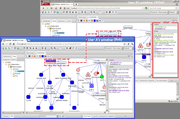Difference between revisions of "Collaborative diagram editing"
(info adapted from a presentation on BioUML collaborative research) |
m |
||
| (One intermediate revision by one user not shown) | |||
| Line 1: | Line 1: | ||
| − | {{ | + | {{stub}} |
| − | Like new writing environments BioUML provides collaborative editing functionality with revision control, and synchronous (real-time) editing. A diagram can be accessed and modified simultaneously by several group members working on a project. Every single change is instantly reflected on the screens of the users viewing the diagram. | + | |
| + | [[File:Collaborative_diagram_editing.png|thumb]] | ||
| + | Like new popular writing environments BioUML provides collaborative editing functionality with revision control, and synchronous (real-time) editing. A [[Diagram document| diagram]] can be accessed and modified simultaneously by several group members working on a project. Every single change is instantly reflected on the screens of the users viewing the diagram. | ||
While working on a single model, users collaborate in several ways. Not only can they introduce changes to the model and immediately see which changes have been introduced by other participants, but also chat to each other and discuss parts of the model pointing at them. A novice participant can ask another, more experienced colleague to build some difficult part and learn how to do it by watching. Alternatively, a user can check another participant's work, correcting as necessary. All of these functions can be achieved in BioUML while editing simulatable models, pathways, workflows and some other. | While working on a single model, users collaborate in several ways. Not only can they introduce changes to the model and immediately see which changes have been introduced by other participants, but also chat to each other and discuss parts of the model pointing at them. A novice participant can ask another, more experienced colleague to build some difficult part and learn how to do it by watching. Alternatively, a user can check another participant's work, correcting as necessary. All of these functions can be achieved in BioUML while editing simulatable models, pathways, workflows and some other. | ||
To start collaborative editing with other users you just need to open the same diagram that has been earlier shared with/by you. | To start collaborative editing with other users you just need to open the same diagram that has been earlier shared with/by you. | ||
| − | + | ||
| + | Whenever you click on a diagram element, it will fade, encompassed by a dotted rectangle, and the selection will be visible to other editors and tagged with your username. This way you can draw other editors' attention to this or that diagram element. | ||
| + | |||
| + | The other editors' actions, such as selections, adding or removing diagram elements, are also visible on your screen. | ||
| + | |||
| + | For better convenience a separate [[User to user communication| chat room]] is available only for the editors, which allows the editors to coordinate their actions effectively. The names of all the users participating in editing the diagram are shown at the top of the chat pane. | ||
| + | |||
| + | ==See also== | ||
| + | * [[Diagram document]] | ||
| + | * [[ User to user communication]] | ||
| + | * [[BioUML#Collaborative research| Collaborative research]] | ||
Latest revision as of 14:21, 14 October 2013
| This page or section is a stub. Please add more information here! |
Like new popular writing environments BioUML provides collaborative editing functionality with revision control, and synchronous (real-time) editing. A diagram can be accessed and modified simultaneously by several group members working on a project. Every single change is instantly reflected on the screens of the users viewing the diagram.
While working on a single model, users collaborate in several ways. Not only can they introduce changes to the model and immediately see which changes have been introduced by other participants, but also chat to each other and discuss parts of the model pointing at them. A novice participant can ask another, more experienced colleague to build some difficult part and learn how to do it by watching. Alternatively, a user can check another participant's work, correcting as necessary. All of these functions can be achieved in BioUML while editing simulatable models, pathways, workflows and some other.
To start collaborative editing with other users you just need to open the same diagram that has been earlier shared with/by you.
Whenever you click on a diagram element, it will fade, encompassed by a dotted rectangle, and the selection will be visible to other editors and tagged with your username. This way you can draw other editors' attention to this or that diagram element.
The other editors' actions, such as selections, adding or removing diagram elements, are also visible on your screen.
For better convenience a separate chat room is available only for the editors, which allows the editors to coordinate their actions effectively. The names of all the users participating in editing the diagram are shown at the top of the chat pane.
